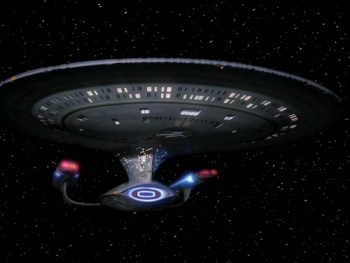Galaxy class

Specifications
| Length | 642.51m[2] |
| Width | 463.73m[2] |
| Height | 195.26m[2] |
| Decks | 42[3] |
| Mass | 4,500,000mt[2] |
| Cargo Capacity | 25,000mt[4] |
| Computer Type | M-9A[5] |
| Transporters (Personnel) | 6[3] |
| Transporters (Cargo) | 8[3] |
| Transporters (Emergency) | 6[3] |
| Crew | 1,012[2] |
| Passengers | 200[2] |
| Evacuation Limit | 15,000[2] |
| Shuttlecraft | 12[5]-44, including 20 Sphinx class Maintenance shuttles;[4] Avg. 24 at a time[6] |
| Cruising speed | Warp 9.2[3] |
| Emergency speed | Warp 9.6 for 12 hours[3] |
| Warp 9.9 for 12 hours (Uprated)[2] | |
| Weapons | 11 Type X Phaser emitters[1][7] |
| 2 torpedo launchers,[1] 250 Type II[8][7] Photon torpedoes;[1] 1 additional launcher in Saucer Module (Uprated),[8][7][9] Type VI Photon torpedoes[6] |
The culmination of an ambitious, 14-year design process, the Galaxy class represented Starfleet's most sophisticated achievement in multimission ship systems design at the time of the commissioning of the lead vessel, the U.S.S. Galaxy NCC-71099 in 2357. When the Galaxy Class Starship Development Project was announced in July 2343, much of the original theoretical work had been accomplished, particularly in the propulsion field. While the attempt to surpass the primary warp field efficiency barrier with the Transwarp Development Project in the 2280s proved unsuccessful, the pioneering achievements in warp power generation and field coil design eventually led to the uprated Excelsior and Ambassador class starships.[3]
Some in Starfleet Command wanted the Galaxy class to serve first and foremost as a warship. A vocal member of that group was Admiral Carstairs, of the Starfleet Operations Planning Board, said that "what we need is something that will frighten our enemies away from territory once and for all. The new Galaxy class is just such an instrument of deterrence." This view, however, was ably countered by the board's Commodore Santin, who responded to Carstairs that "converting this class into the ultimate battlewagon—as you have described it on more than one occasion—may well have an effect opposite the one you desire."[4]
Starfleet Command initially ordered six Galaxy class ships. A projected total of twelve vessels were held as an option to be activated, should conditions warrant. Once the initial spaceframe design was finalized, it was decided to proceed with the completion of six vessels and to take the other six to the end of the framework stage only. These six spaceframes were broken down into manageable segments and dispersed by cargo carriers to remote sites within the Federation as a security measure.[3]
Pursuant to Starfleet Exploration Directive 902.3, the following objectives were established for the Galaxy Class Starship Development Project:
- Provide a mobile platform for a wide range of ongoing scientific and cultural research projects;
- Replace aging Ambassador and Oberth class starships as primary instruments of Starfleet's exploration programs;
- Provide autonomous capability for full execution of Federation policy options in outlying areas;
- Incorporate recent advancements in warp power-plant technology and improved science instrumentation.[3]
Saucer Module Separation
The Galaxy class consists of two spacecraft systems integrated to form a single, functional vessel. Under specific emergency conditions, the two vehicle elements may perform a separation maneuver and continue independent operation. The two elements, the Saucer Module and the Stardrive—or Battle—Section, were normally joined together by a series of eighteen structural docking latches, numerous umbilicals, and turbolift pass-throughs. Risks and vehicle stress associated with repeated undockings and redockings, however, prevented frequent use of the separation maneuver. In the event the Saucer Module was disabled near a planetary body and could not maintain a stable orbit, landing the saucer was the final option.[3]
Main Engineering
The Main Engineering control center on Deck 36 served as a master control for the ship's warp propulsion system, as well as the impulse propulsion system and other engineering systems. Main Engineering also served as a backup control center in the event of failure of the Main Bridge and the Battle Bridge. Workstations at this location could be reconfigured to emulate Conn, Ops, Tactical, and other command operations.[3]
Dominion War
During the Dominion War, a number of Galaxy class hulls were pulled from the internal structures work path, equipped with additional weapons, and launched with 65% of their spaceframe volumes empty.[2]
Galaxy class vessels
- U.S.S. Challenger NCC-71099
- U.S.S. Dauntless NCC-71879
- U.S.S. Enterprise NCC-1701-D
- I.S.S. Enterprise NCC-1701-D
- U.S.S. Enterprise NCC-1701-D (Alternate)
- U.S.S. Excalibur NCC-26517-A
- U.S.S. Galaxy NCC-70637
- U.S.S. Magellan NCC-71820
- U.S.S. Odyssey NCC-71832
- U.S.S. Trident NCC-78143
- U.S.S. Trinculo NCC-71867
- U.S.S. Ulysses
- U.S.S. Venture NCC-71854
- U.S.S. Yamato NCC-71807
References
- ↑ 1.0 1.1 1.2 1.3 "Encounter at Farpoint." Star Trek: The Next Generation, Episodes 101-102. Television. 28 September 1987.
- ↑ 2.0 2.1 2.2 2.3 2.4 2.5 2.6 2.7 2.8 "Star Trek: Deep Space Nine Technical Manual." Star Trek: Deep Space Nine. Book. November 1998. Pocket Books.
- ↑ 3.00 3.01 3.02 3.03 3.04 3.05 3.06 3.07 3.08 3.09 3.10 "Star Trek: The Next Generation Technical Manual." Star Trek: The Next Generation. Book. November 1991. Pocket Books.
- ↑ 4.0 4.1 4.2 "Star Trek: The Next Generation Officer's Manual." Star Trek: The Roleplaying Game, Supplement 2012. Game. 1988. FASA.
- ↑ 5.0 5.1 "Star Trek: The Next Generation First Year Sourcebook." Star Trek: The Roleplaying Game, Supplement 2227. Game. 1989. FASA.
- ↑ 6.0 6.1 "Narrator's Guide." Star Trek Roleplaying Game, Book 2. Game. 2002. Decipher, Inc.
- ↑ 7.0 7.1 7.2 "Player's Guide." Star Trek Roleplaying Game, Book 1. Game. 2002. Decipher, Inc.
- ↑ 8.0 8.1 "Core Game Book." Star Trek: The Next Generation Roleplaying Game, Supplement 45000. Game. 1999. Last Unicorn Games, Inc.
- ↑ "Starships." Star Trek Roleplaying Game, Book 4. Game. 2003. Decipher, Inc.